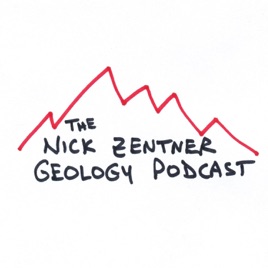
Advertise on podcast: Geology Bites
Rating
4.8 from
Country
This podcast has
86 episodes
Language
Publisher
Explicit
No
Date created
2020/07/29
Average duration
33 min.
Release period
29 days
Description
What moves the continents, creates mountains, swallows up the sea floor, makes volcanoes erupt, triggers earthquakes, and imprints ancient climates into the rocks? Oliver Strimpel, a former astrophysicist and museum director asks leading researchers to divulge what they have discovered and how they did it. To learn more about the series, and see images that support the podcasts, go to geologybites.com. Instagram: @GeologyBites Twitter: @geology_bites Email: geologybitespodcast@gmail.com
Podcast episodes
Check latest episodes from Geology Bites podcast
Damian Nance on What Drives the Supercontinent Cycle
2024/02/24
Perhaps as many as five times over the course of Earth history, most of the continents gathered together to form a supercontinent. The supercontinents lasted on the order of a hundred million years before breaking apart and dispersing the continents. For decades, we theorized that this cycle of amalgamation and breakup was caused by near-surface tectonic processes such as subduction that swallowed the oceans between the continents and upper mantle convection that triggered the rifting that split the supercontinents apart. As Damian Nance explains in the podcast, newly acquired evidence suggests a very different picture in which the supercontinent cycle is the surface manifestation of a process that involves the entire mantle all the way to the core-mantle boundary.
Damian Nance draws on a wide range of geological evidence to formulate theories about the large-scale dynamics of the lithosphere and mantle spanning a period going back to the Archean. A major focus of his research is the supercontinent cycle. He is Distinguished Professor Emeritus of Geological Sciences at Ohio University.
more
David Kohlstedt on Simulating the Mantle in the Lab
2024/02/09
The Earth’s tectonic plates float on top of the ductile portion of the Earth’s mantle called the asthenosphere. The properties of the asthenosphere, in particular its viscosity, are thought to play a key role in determining how plates move, subduct, and how melt is produced and accumulates. We would like to know what the viscosity of the the asthenosphere is, and how it depends on temperature, pressure, and the proportion of melt and water it contains. Few mantle rocks ever reach the Earth’s surface, and those that do are altered by weathering. So, as he explains in the podcast, David Kohlstedt and his team have tried to replicate the rock compositions and physical conditions of the mantle in the lab. Using specially-built apparatus, he has been able to determine the viscosity of the asthenosphere to within an order of magnitude, which is an enormous improvement on what was known before.
David Kohlstedt is Professor Emeritus at the School of Earth and Environmental Science at the University of Minnesota.
more
Claire Corkhill on Geological Radioactive Waste Disposal
2024/01/07
In many countries, nuclear power is a significant part of the energy mix being planned as part of the drive to achieve net-zero greenhouse-gas emissions. This means that we will be producing a lot more radioactive waste, some of it with half-lives that approach geological timescales, which are orders of magnitude greater than timescales associated with human civilizations. In the podcast, Claire Corkhill discusses the geology such storage sites require, some new materials that can confine radioactive isotopes over extremely long timescales, and the kind of hazards, including human, we need to guard against.
Claire Corkhill is Professor of Mineralogy and Radioactive Waste Management in the School of Earth Sciences at the University of Bristol, UK.
more
Mahesh Anand on What Human Return to the Moon Means for Lunar Geology
2023/12/22
We have learned a great deal about the geology of the Moon from remote sensing instruments aboard lunar orbiters, from robot landers, from the Apollo landings, and from samples returned to the Earth by Apollo and robot landings. But in 2025, when NASA plans to land humans on the Moon for the first time since 1972, a new phase of lunar exploration is expected to begin. What will this mean for our understanding of the origin, evolution, and present structure of the Moon? A lot, according to Mahesh Anand. For example, as he explains in the podcast, satellite imagery suggests that volcanism continued for much longer than was previously thought, perhaps until as recently as 100 million years ago. In-situ inspection and sample return should help us explain this surprising finding.
Mahesh Anand is Professor of Planetary Science and Exploration at the Open University, UK.
more
Susan Brantley on Earth's Geological Thermostat
2023/12/10
At the core of Earth’s geological thermostat is the dissolution of silicate minerals in the presence of atmospheric carbon dioxide and liquid water. But at large scales, the effectiveness and temperature sensitivity of this reaction depends on geomorphological, climatic, and tectonic factors that vary greatly from place to place. As described in the podcast, to predict watershed-scale or global temperature sensitivity, Susan Brantley characterizes these factors using the standard formula for the temperature dependence of chemical reaction rates using an empirically-determined activation energy for each process. Overall, her results suggest a doubling of the weathering rate for each 10-degree rise in temperature, but this value changes with the spatial scale of the analysis.
Susan Brantley is a Professor in the Department of Geosciences at Pennsylvania State University.
more
Clark Johnson on the Banded Iron Formations
2023/11/12
Banded Iron Formations (BIFs) are a visually striking group of sedimentary rocks that are iron rich and almost exclusively deposited in the Precambrian. Their existence points to a major marine iron cycle that does not operate today. Several theories have been proposed to explain how the BIFs formed. While they all involve the precipitation of ferric (Fe3+) iron hydroxides from the seawater via oxidation of dissolved ferrous (Fe2+) iron that was abundant when the oceans contained very low levels of free oxygen, they disagree as to how this oxidation occurred. In the podcast, Clark Johnson describes how oxidation could have occurred without the presence of abundant free oxygen in the oceans.
Clark Johnson is a Professor Emeritus in the Department of Geoscience at the University of Wisconsin-Madison.
more
Catherine Mottram on Dating Rock Deformation
2023/10/18
The geological history of most regions is shaped by a whole range of processes that occur at temperatures ranging from above 800°C to as low as 100°C. The timing of events occurring over a particular temperature range can be recorded by a mineral which crystallizes over that range. The mineral calcite is suitable for recording low-temperature processes such as fossilization, sedimentation, and fluid flow, and it is especially useful as it is virtually ubiquitous. But using uranium-lead radiometric dating in calcite is very challenging as it often contains very little uranium and the ragiogenically-produced lead isotopes can be swamped by common lead within a calcite crystal. In the podcast, Catherine Mottram explains how these challenges are being overcome and shares some of her findings based on radiometric dating of calcite.
Mottram is an Associate Professor of Geology at the University of Portsmouth.
more
Martin Van Kranendonk on the Earliest Life on Earth
2023/09/12
In this episode, Martin Van Kranendonk lays out a convincing case for life on Earth going back to at least 3.48 billion years ago.
To find evidence for very ancient life, we need to look at rocks that have been largely undisturbed over billions of years of Earth history. Such rocks have been found in the Pilbara region of northwest Australia. As explained in the podcast, the 3.48-billion-year-old (Ga) rocks of the Pilbara's Dresser Formation contain exceptionally well-preserved features that show unmistakeable physical and chemical signatures of life. While older 3.7 Ga rocks in west Greenland may also prove to have harbored life, the Dresser Formation rocks represent the oldest widely accepted evidence for life on Earth.
Martin Van Kranendonk has devoted his long and prolific research career to the study of the early Earth. One major theme of his work has been to use detailed mapping and lab research to develop geological models for the environments of Earth’s oldest fossils. This has helped establish the biological origin of many ancient fossils. His recent work on a newly discovered find of exceptionally well-preserved 3.5-billion-year-old sedimentary rocks in the Pilbara Craton of Western Australia has provided the strongest evidence to date that structures of this great age were produced by the earliest forms of life.
Martin Van Kranendonk is a Professor in the School of Biological, Earth, & Environmental Sciences at the University of New South Wales in Sydney.
more
Rob Butler on the Origin of the Alps
2023/08/17
The Alps are the most intensively studied of all mountain chains, being readily accessed from the geological research centers of Europe. But despite this, there remains considerable uncertainty as to how they formed, especially in the Eocene (about 40 million years ago) when the events that led directly to Alpine mountain-building started. In the podcast, Rob Butler explains how much of this uncertainty stems from our fragmentary knowledge of the locations and structures of sedimentary basins and small continental blocks that lay between Europe and Africa at that time. In his research, he combines detailed studies of the sedimentary rocks flanking the Alps with the large body of structural and petrological knowledge amassed over the past two centuries to try to unravel the sequence of events leading up to the formation of the Alps.
Rob Butler is Professor of Tectonics at the University of Aberdeen, Scotland, UK.
more
John Wakabayashi on the Franciscan Complex
2023/07/03
The Franciscan Complex is a large accretionary prism that has been accreted onto the western margin of the North American continent. Unlike most such prisms, which are submarine, it is exposed on land, making it a magnet for researchers such as John Wakabayashi. In the podcast, he describes this remarkable complex and explains the mechanisms that may have operated over its 150-million-year history.
John Wakabayashi is a Professor in the Department of Earth and Environmental Sciences at California State University, Fresno. He has devoted much of his 40-year research career to the Franciscan Complex.
more
Bruce Levell on Bias in the Sedimentary Record
2023/06/20
How can we tell if the sedimentary record is good enough to make solid inferences about the geological past? After all, it can be difficult, or even impossible, to infer what is missing, or indeed whether anything is missing at all.
As he explains in the podcast, Bruce Levell tackles this question by combining fieldwork with systematic analysis based on what we know about contemporary deposition and erosion. Armed with an understanding of preservational bias, he questions the confidence with which some widely held interpretations of the sedimentary record have been made. For example, by analyzing sequences of glacially-deposited rocks in southwest Scotland, he has shown with others that, contrary to the “Hard Snowball Earth” hypothesis, parts of the Earth probably experienced a persistently active hydrological cycle and were not simply fully-frozen, at least during the earlier of the two postulated snowball glaciations.
Bruce Levell is a Visiting professor in the Department of Earth Sciences at the University of Oxford. Previously, he was Chief Scientist for Geology at Royal Dutch Shell.
more
Sujoy Mukhopadhyay on Probing the Hadean World with Noble Gases
2023/04/20
In a recent episode, Nadja Drabon spoke about newly discovered zircon crystals that formed during the late Hadean and early Archean, when the Earth was between 500 million and a billion years old. The zircons revealed information about processes occurring in the Earth’s nascent crust, casting light on when and how modern-day plate tectonics may have started. In this episode, we talk about a very different source of information about the early Earth, namely the abundances of noble gases occurring within present-day basalts. It turns out that these can probe the Earth’s mantle and atmosphere even further back in time – to the first 100 million years of Earth history.
Sujoy Mukhopadhyay leads a team of researchers who have developed new techniques for measuring the abundances of noble gas isotopes in a variety of Earth materials. By combining the results of these measurements with geochemical models, he has shed light on questions about the very early Earth and planet formation that have challenged researchers for decades. Here we focus on one of these: “Do any structures originating from the very early Earth survive in today’s mantle?” Amazingly, the answer is "yes."
Sujoy Mukhopadhyay is Professor of Geochemistry at the University of California, Davis.
more
Podcast reviews
Read Geology Bites podcast reviews
MTrudnak
2024/02/01
Awesome pod!
This podcast has very quickly become one of my favorites. Diverse range of topics and all extremely engaging!
Thanks Oliver.
Huachuca Rock Hound
2024/01/19
High level content
This is not a dumbed down version of earth science topics but rather a high level discussion of important topics in the field of geology. Absolutely o...
more
kristi history
2023/12/04
Thank you
I LOVE this podcast. Pure science no agenda.
Collegebasketballonly
2023/09/12
Great source of information
Great show! As always.
Love to hear your guest’s say,
Extraordinary ideas require extraordinary evidence.
Makes their new information to me much mo...
more
Annliarubio
2023/01/22
Interesting and Well Produced
This is a topic that has always fascinated me and it is exciting to listen to all of the guests and the host is excellent. My daughter just got her MS...
more
Kitgeology
2022/03/14
Concise and Informing
The podcast is concise, interesting, and informative. Extraneous information or banter is not part of Geology Bites podcasts. Geology Bites provides ...
more
guz42
2022/07/30
Accessible but not dumbed down
If you love geology and remember a bit of Earth Science from 9th grade, you will enjoy this podcast. The host does an excellent job of translating and...
more
Deming Fan
2022/02/22
Great podcast.
I’m what scholars might call a moron. I have just enough knowledge of geology to convince myself that I’m learning something that I can incorporate in...
more
Guto the geologist
2022/02/06
The podcast I’ve been looking for
The caliber of guests on this show is world class. The conversation is informative yet easy to follow. I’ve been lucky enough to study under a few o...
more
CurlsintheSquatRack
2021/11/13
Excellent information
Concise interviews with geology researchers. Excellent audio quality. Has a great companion website as well.
Podcast sponsorship advertising
Start advertising on Geology Bites & sponsor relevant audience podcasts
You may also like these earth sciences Podcasts

4.9
77
235
The Mineral Rights Podcast: Mineral Rights | Royalties | Oil and Gas | Matt Sands
Matt Sands

5
4
26
Backyard Geology
TravelingGeologist

4.9
474
100
The Nick Zentner Geology Podcast
Nick Zentner

5
2
45
MassRecycle Podcast
MassRecycle

4.6
259
98
Dinosaur George Kids - A Show for Kids Who Love Dinosaurs
Dinosaur George

4.9
41
59
Cutting Carbon
GE Gas Power

4.9
69
27
Forestcast
USDA Forest Service

4.9
376
221
Spacepod
Carrie Nugent

3.2
9
41
Christian Flat Earth Ministry
James Edwards

5
1
104
Fossil Huntress — Palaeo Sommelier
Fossil Huntress



